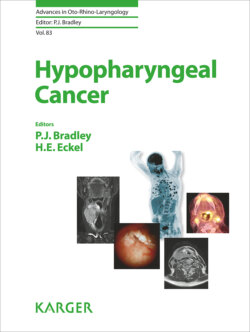Читать книгу Hypopharyngeal Cancer - Группа авторов - Страница 37
На сайте Литреса книга снята с продажи.
Co-Morbidity
ОглавлениеSmoking and alcohol consumption are the major causal factors associated with hypopharyngeal cancer as well as for other chronic diseases like cardiovascular or pulmonary diseases, as well as more than 85% are diagnosed with advanced stage disease, and are over 60 years of age, all contributing to their likelihood of a higher co-morbidity [39]. Therefore, many patients with a primary diagnosis of hypopharyngeal cancer have co-morbidities that influence clinical decision making, treatment possibilities, and survival. Severe and/or multiple co-morbidities may compel the administration of less radical treatments or procedures resulting in a poor cancer-specific survival. Advanced age in itself may be a prognostic factor and a determinant of treatment decisions. The implementation of low intensity treatment, as decided based on co-morbidity or age, is likely to worsen oncologic outcome. A number of co-morbidity indices have been described [40, 41]. The most commonly used are the Adult Comorbidity Evaluation-27 index (ACE-27) and the Charlson co-morbidity index [42, 43]. The ACE-27 index is a validated instrument widely used in head and neck cancer [41], which uses 27 different cogent co-morbid ailments. In this system, co-morbidity is classified into 3 categories in accordance with severity: severe, moderate and mild. Not much data has been published, specifically on patients with hypopharyngeal cancer.
One retrospective medical record review of 156 patients with hypopharyngeal cancer from Japan [44] using the ACE-27 index reported the absence of co-morbidity in 55 (35.2%) patients, mild in 39 (25%), moderate in 28 (17.9%) and severe in 34 (21.8%). Age, stage and comorbidity were identified as independent prognostic factors in multivariate analysis. There were statistically significant differences between the survival rates, between age, stage, sub-sites and co-morbidity (45.1% for none or mild vs. 27.7% for moderate or severe; p = 0.0073). Age, stage and co-morbidity were identified as independent prognostic factors in the multivariate analysis. They concluded that co-morbidity along with clinical stage should be considered in treatment planning for patients with hypopharyngeal cancer.
Another retrospective chart review from Japan [45] used the Charlton comorbidity index as a prognostic indicator studied 128 patients diagnosed with advanced loco-regional hypopharyngeal cancer treated by concurrent chemoradiation therapy. They reported that patients with severe comorbidities received surgery or less-intensive therapy than chemoradiotherapy, and had interruptions to treatments as well as not completing planned treatment resulting in a worse outcome.
